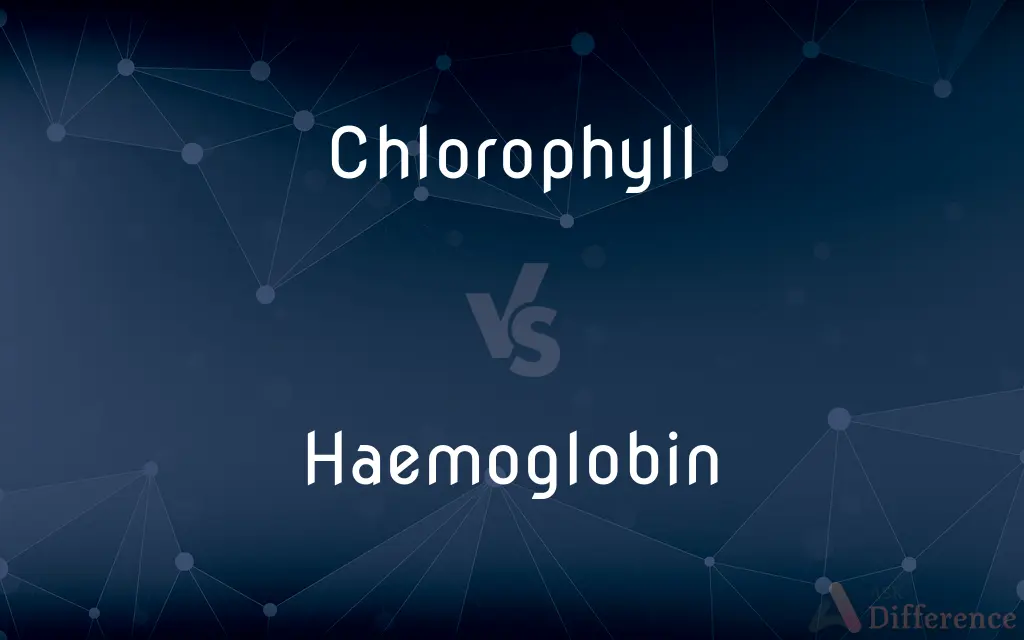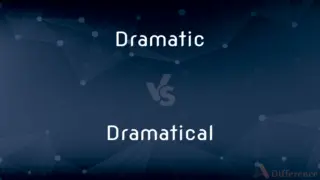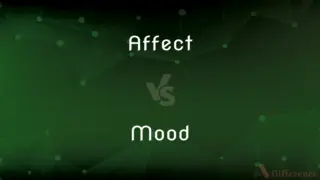Chlorophyll vs. Haemoglobin — What's the Difference?
By Maham Liaqat & Urooj Arif — Updated on March 13, 2024
Chlorophyll is a pigment found in plants essential for photosynthesis, while Hemoglobin is a protein in red blood cells vital for oxygen transport in animals.

Difference Between Chlorophyll and Haemoglobin
Table of Contents
ADVERTISEMENT
Key Differences
Chlorophyll, the green pigment in plants, algae, and cyanobacteria, plays a crucial role in photosynthesis, the process by which light energy is converted into chemical energy, fueling plant growth and oxygen production. Hemoglobin, on the other hand, is a complex protein found in the red blood cells of vertebrates and some invertebrates. It's responsible for transporting oxygen from the lungs to the body's tissues and returning carbon dioxide from the tissues back to the lungs.
While chlorophyll is contained within the chloroplasts of plant cells, where it captures light energy, hemoglobin is located within red blood cells, circulating in the bloodstream to deliver oxygen to various parts of the body.
The structure of chlorophyll allows it to absorb light most efficiently in the blue and red wavelengths, reflecting green light, which is why plants appear green. Hemoglobin's structure enables it to bind oxygen molecules, changing color from dark red to bright red upon oxygen binding.
Both chlorophyll and hemoglobin share a similar structure at their core, with chlorophyll containing magnesium and hemoglobin containing iron. This similarity hints at an evolutionary connection between the photosynthesis of plants and the metabolic processes of animals.
Comparison Chart
Function
Absorbs light for photosynthesis.
Transports oxygen in the bloodstream.
ADVERTISEMENT
Location
In the chloroplasts of plant cells.
In the red blood cells of vertebrates and some invertebrates.
Role in Ecosystem
Produces oxygen and organic compounds through photosynthesis.
Facilitates aerobic respiration by delivering oxygen.
Appearance
Green pigment, reflects green light.
Red protein, color changes with oxygen binding.
Core Element
Contains magnesium at its center.
Contains iron at its center.
Compare with Definitions
Chlorophyll
Enables plants to convert light energy into chemical energy.
Chlorophyll in the leaves captures sunlight for photosynthesis.
Haemoglobin
Carries oxygen from the lungs to body tissues.
Hemoglobin in the blood ensures tissues receive enough oxygen.
Chlorophyll
Gives plants their green color.
The chlorophyll in the grass makes it appear green.
Haemoglobin
Enables efficient energy production in cells.
Hemoglobin's efficiency affects overall physical endurance.
Chlorophyll
Efficiently absorbs light in the blue and red spectrums.
Chlorophyll's absorption spectrum is optimal for photosynthesis.
Haemoglobin
Contains iron, essential for its oxygen-binding capacity.
Iron deficiency can impair hemoglobin's ability to transport oxygen.
Chlorophyll
Plays a key role in reducing carbon dioxide levels.
Forests rich in chlorophyll are crucial for carbon sequestration.
Haemoglobin
Assists in transporting carbon dioxide back to the lungs.
Hemoglobin helps maintain the body's pH balance by CO2 transport.
Chlorophyll
Vital for the energy production of plants.
Chlorophyll deficiency can lead to stunted plant growth.
Haemoglobin
Changes color based on oxygen saturation.
Oxygenated hemoglobin is bright red, enhancing the color of arterial blood.
Chlorophyll
Chlorophyll (also chlorophyl) is any of several related green pigments found in the mesosomes of cyanobacteria and in the chloroplasts of algae and plants. Its name is derived from the Greek words χλωρός, khloros ("pale green") and φύλλον, phyllon ("leaf").
Haemoglobin
Alternative spelling of hemoglobin
Chlorophyll
A waxy blue-black microcrystalline green-plant pigment, C55H72MgN4O5, with a characteristic blue-green alcohol solution. Also called chlorophyll a.
Haemoglobin
Same as Hemoglobin.
Chlorophyll
A similar green-plant pigment, C55H70MgN4O6, having a brilliant green alcohol solution. Also called chlorophyll b.
Haemoglobin
A hemoprotein composed of globin and heme that gives red blood cells their characteristic color; function primarily to transport oxygen from the lungs to the body tissues;
Fish have simpler hemoglobin than mammals
Chlorophyll
(biochemistry) Any of a group of green pigments that are found in the chloroplasts of plants and in other photosynthetic organisms such as cyanobacteria.
Chlorophyll
Literally, leaf green; a green granular matter formed in the cells of the leaves (and other parts exposed to light) of plants, to which they owe their green color, and through which all ordinary assimilation of plant food takes place. Similar chlorophyll granules have been found in the tissues of the lower animals.
Chlorophyll
Any of a group of green pigments found in photosynthetic organisms. Chlorophyll a and chlorophyll b are found in higher plants and green algae; chlorophyll c is found in certain types of marine algae. Chemically, it has a porphyrin ring with a magnesium ion bound to the four central nitrogens, and has a phytyl side chain. It is essential for photosynthesis in most plants. Chlorophyll a has formula C55H72N4O5Mg.
Chlorophyll
Any of a group of green pigments found in photosynthetic organisms
Common Curiosities
How does hemoglobin function in the body?
Hemoglobin transports oxygen from the lungs to the body's tissues and carries carbon dioxide back to the lungs.
Why are plants green?
Plants appear green because chlorophyll reflects green light while absorbing other wavelengths for photosynthesis.
What is the primary function of chlorophyll in plants?
Chlorophyll is essential for photosynthesis, allowing plants to convert sunlight into energy.
What happens in chlorophyll deficiency?
Chlorophyll deficiency, known as chlorosis, can lead to reduced photosynthesis and plant growth.
How does hemoglobin deficiency affect the body?
Hemoglobin deficiency, or anemia, can result in decreased oxygen transport, causing fatigue and other health issues.
Are there synthetic forms of chlorophyll and hemoglobin?
Yes, synthetic forms are used in various applications, including medical therapies and food coloring.
What causes the red color of blood?
The red color of blood is due to the presence of hemoglobin, which turns bright red when it binds to oxygen.
What element is central to chlorophyll's structure?
Magnesium is at the core of chlorophyll's structure.
What element is essential for hemoglobin's function?
Iron is a crucial component of hemoglobin, enabling it to bind oxygen.
How do chlorophyll and hemoglobin contribute to their respective ecosystems?
Chlorophyll contributes to oxygen production and carbon sequestration, while hemoglobin is vital for aerobic respiration in animals.
Can chlorophyll and hemoglobin be found in the same organism?
No, chlorophyll is exclusive to photosynthetic organisms like plants, while hemoglobin is found in animals.
Can chlorophyll be beneficial to human health?
Chlorophyll is believed to have various health benefits, including detoxification and wound healing, though more research is needed.
What medical conditions are related to hemoglobin levels?
Conditions include anemia, polycythemia, and various hemoglobinopathies like sickle cell disease.
What is the significance of the iron in hemoglobin?
Iron allows hemoglobin to bind oxygen, making it crucial for its role in oxygen transport.
How is the efficiency of chlorophyll in photosynthesis measured?
It's measured by the rate of photosynthesis, which can be influenced by light intensity, CO2 levels, and chlorophyll concentration.
Share Your Discovery

Previous Comparison
Dramatic vs. Dramatical
Next Comparison
Affect vs. MoodAuthor Spotlight
Written by
Maham LiaqatCo-written by
Urooj ArifUrooj is a skilled content writer at Ask Difference, known for her exceptional ability to simplify complex topics into engaging and informative content. With a passion for research and a flair for clear, concise writing, she consistently delivers articles that resonate with our diverse audience.
















































